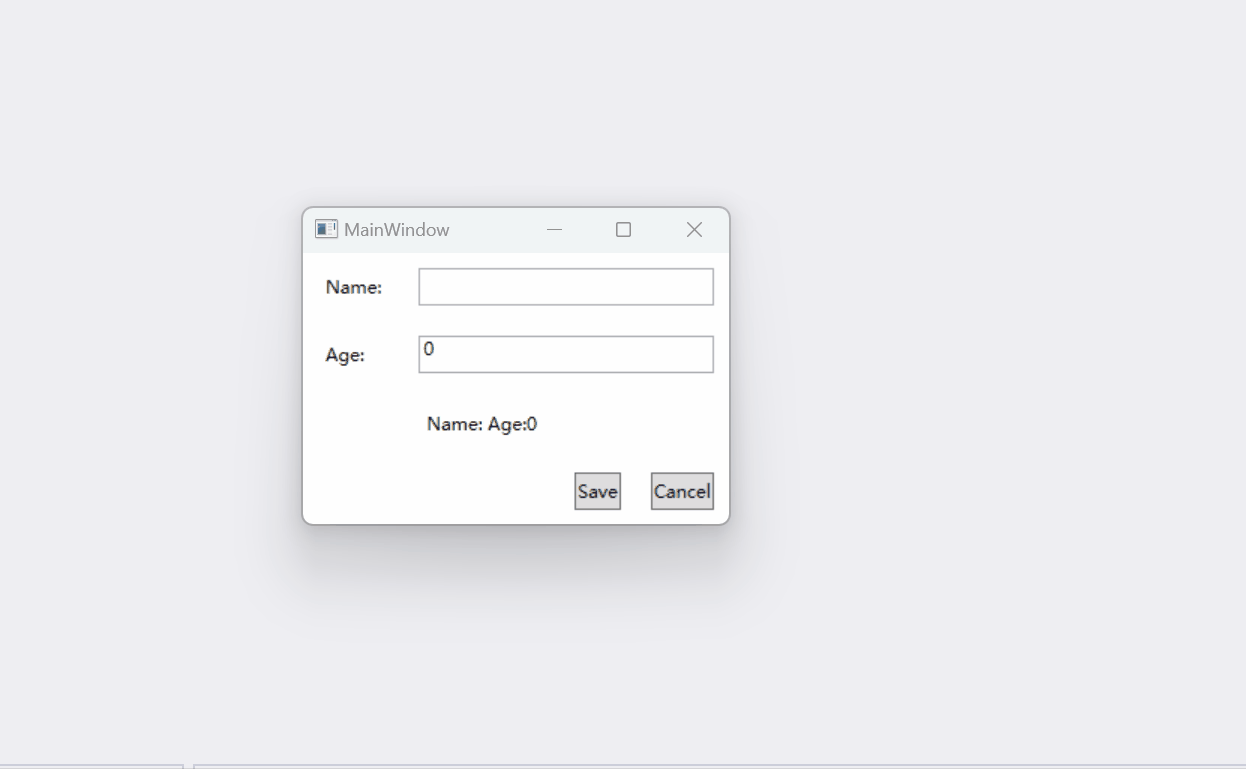WPF是Windows Presentation Foundation的缩写,它是一种用于创建桌面应用程序的用户界面框架。WPF支持多种开发模式,其中一种叫做MVVM(Model-View-ViewModel)。
什么是MVVM?
MVVM是一种软件架构模式,它将应用程序分为三个层次:Model(模型),View(视图)和ViewModel(视图模型)。Model表示应用程序的数据和业务逻辑,View表示应用程序的用户界面,ViewModel表示View和Model之间的桥梁,它负责处理View的数据绑定和用户交互。
为什么要使用MVVM?
使用MVVM有以下几个好处:
- 降低了View和Model之间的耦合度,使得它们可以独立地开发和测试。
- 提高了代码的可重用性和可维护性,因为ViewModel可以在不同的View之间共享。
- 简化了单元测试,因为ViewModel不依赖于具体的UI控件。
- 支持双向数据绑定,使得View可以自动更新Model的变化,反之亦然。
- 利用了WPF提供的强大特性,如命令、依赖属性、数据注解等。
下图我们可以直观的理解MVVM谁急模式:

View: 使用XAML呈现给用户的界面,负责与用户交互,接收用户输入,把数据展现给用户。
Model: 事物的抽象,开发过程中涉及到的事物都可以抽象为Model,例如姓名、年龄、性别、地址等属性.不包含方法,也不需要实现INotifyPropertyChanged接口.
ViewModel: 负责收集需要绑定的数据和命令,聚合Model对象,通过View类的DataContext属性绑定到View。同时也可以处理一些UI逻辑。
如何实现MVVM?
实现MVVM需要遵循以下几个步骤:
- 创建一个Model类,定义应用程序所需的数据和业务逻辑。
- 创建一个ViewModel类,继承自INotifyPropertyChanged接口,并实现属性变更通知。在ViewModel中定义与Model相关联的属性,并提供相应的命令来执行用户操作。
- 创建一个View类(通常是一个XAML文件),定义应用程序的用户界面。在View中使用数据绑定来连接ViewModel中的属性和命令,并设置相关的样式和行为。
- 在App.xaml或其他合适的地方创建一个ViewModel实例,并将其作为View中DataContext属性值。
- 示例代码:
// Model class
public class User
{
public string Name { get; set; }
public int Age { get; set; }
}
// ViewModel class
using System;
using System.Collections.Generic;
using System.ComponentModel;
using System.Linq;
using System.Text;
using System.Threading.Tasks;
using System.Windows.Input;
using System.Windows;
namespace WpfApp1
{
public class UserInfoViewModel : INotifyPropertyChanged
{
private User user;
public UserInfoViewModel()
{
user = new User();
SaveCommand = new RelayCommand(Save);
CancelCommand = new RelayCommand(Cancel);
}
public string UserName
{
get { return user.Name; }
set
{
user.Name = value;
OnPropertyChanged("UserName");
}
}
public int UserAge
{
get { return user.Age; }
set
{
user.Age = value;
OnPropertyChanged("UserAge");
}
}
public string UserInfo
{
get { return $"Name:{UserName} Age:{UserAge}"; }
}
public ICommand SaveCommand { get; private set; }
public ICommand CancelCommand { get; private set; }
private void Save(object parameter)
{
// Save user data to database or service
MessageBox.Show("User data saved!");
OnPropertyChanged("UserInfo");
}
private void Cancel(object parameter)
{
// Close dialog window without saving data
var window = parameter as Window;
if (window != null)
window.Close();
}
public event PropertyChangedEventHandler PropertyChanged;
protected void OnPropertyChanged(string propertyName)
{
if (PropertyChanged != null)
PropertyChanged(this, new PropertyChangedEventArgs(propertyName));
}
}
}
//Command class
public class RelayCommand : ICommand
{
public RelayCommand(Action<object> action)
{
DoExecute = action;
}
public event EventHandler? CanExecuteChanged;
public Func<object, bool>? CanExecution { set; get; }
public Action<object>? DoExecute { set; get; }
public bool CanExecute(object? parameter)
{
if (CanExecution != null)
{
CanExecute(parameter);
}
return true;
}
public void Execute(object? parameter)
{
DoExecute!.Invoke(parameter!);
}
}// View class (XAML file)
<Window x:Class="WpfApp1.MainWindow"
xmlns="http://schemas.microsoft.com/winfx/2006/xaml/presentation"
xmlns:x="http://schemas.microsoft.com/winfx/2006/xaml"
Title="MainWindow" Height="220" Width="300">
<Grid>
<Grid.RowDefinitions>
<RowDefinition Height="Auto"/>
<RowDefinition Height="Auto"/>
<RowDefinition Height="Auto"/>
<RowDefinition Height="*"/>
</Grid.RowDefinitions>
<Grid.ColumnDefinitions>
<ColumnDefinition Width="Auto"/>
<ColumnDefinition Width="*"/>
</Grid.ColumnDefinitions>
<!-- Labels and textboxes for user name and age -->
<Label Content="Name:" Grid.Row="0" Grid.Column="0" Margin="10"/>
<TextBox Text="{Binding UserName}" Grid.Row="0" Grid.Column="1" Margin="10"/>
<Label Content="Age:" Grid.Row="1" Grid.Column="0" Margin="10"/>
<TextBox Text="{Binding UserAge}" Grid.Row="1" Grid.Column="1" Margin="10"/>
<Label Content="{Binding UserInfo}" Grid.Row="2" Grid.Column="1" Margin="10"/>
<!-- Buttons for save and cancel commands -->
<StackPanel Orientation= "Horizontal" HorizontalAlignment= "Right"
Grid.Row= "3" Grid.ColumnSpan= "2">
<Button Content= "Save" Command="{Binding SaveCommand}"
CommandParameter="{Binding RelativeSource={RelativeSource FindAncestor,
AncestorType={x:Type Window}}}" Margin= "10"/>
<Button Content= "Cancel" Command="{Binding CancelCommand}"
CommandParameter="{Binding RelativeSource={RelativeSource FindAncestor,
AncestorType={x:Type Window}}}" Margin= "10"/>
</StackPanel>
</Grid>
</Window>// View code-behind file
using System.Windows;
namespace WpfApp1
{
/// Interaction logic for UserInfoView.xaml
public partial class MainWindow : Window
{
public MainWindow()
{
InitializeComponent();
// Set the ViewModel as the DataContext of the View
this.DataContext = new UserInfoViewModel();
}
}
}运行结果如下:

代码位置:
https://github.com/DXG88/WpfApp1.git
有哪些MVVM框架?
虽然可以手动实现MVVM模式,但是也有许多第三方库提供了更方便和高效地使用MVVM模式。以下是一些常见且流行的MVVM框架:
- Prism: 一个由微软支持的MVVM框架,提供了一系列服务和特性,如导航、模块化、事件聚合、命令、依赖注入等。
- MVVM Light: 一个轻量级的MVVM框架,提供了一些基础类和组件,如ViewModelBase, RelayCommand, Messenger等。
- Caliburn.Micro: 一个基于约定而非配置的MVVM框架,提供了一些高级特性,如屏幕激活/关闭生命周期管理、自动绑定、窗口管理器等。
作者:百宝门-董校刚























